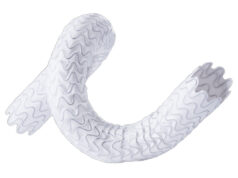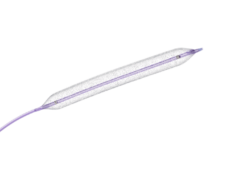
Endovascular arteriovenous fistulas (endoAVF) platforms add additional fistula options for patients and physicians, argues Dheeraj Rajan (University Health Network, University of Toronto, Toronto, Canada, and a paid consultant for BD) at the 2019 Vascular and InterVentional Advances meeting (VIVA; 4–7 November, Las Vegas, USA). He argues that, due to higher patient satisfaction, good technical success, and low complication rates, as well as the attendant cost savings, endovascular AVF creation will soon be “essential” for any dialysis programme.
The first AV fistula, described in 1966 by Michael Brescia, James Cimino, Kenneth Appel, and Baruch Hurwich (all Veterans Administration Hospital, New York, USA), involved the side to side surgical anastomosis of the patient’s cephalic vein and radial artery near the wrist.
“It is important to note,” Rajan said to the VIVA audience, “that over 50 years [since the first AV fistula], we are still talking about the surgical creation of AV fistulas; not a lot has changed in that time. If you think about what kind of innovation has happened in different areas of medicine over those 50 years, and compare it to that in dialysis access, then you can see that we have not really had a lot of innovation in this space.”
He thinks this is changing, however, predicting the mainstream adoption of endovascular AVF creation.
Rajan highlighted the 20–60% failure rate of surgical AVFs to mature, as reported in “meta-analyses and multiple, large studies”—though he did also note that, anecdotally, AVFs may have a higher maturation rate, with several conference attendees reporting a 90% success rate in their own experience. In addition, he told delegates that 80% of patients start dialysis with a central venous catheter (CVC) in place, which he said “is not good for the patient”. Added to these downsides of surgical AVF creation, he commented, “In the world of patient-centred care, it is important to note that 30% of patients do not want to get surgery. It is something we rarely talk about.”
There are two devices currently commercially available for endovascular AVF creation: the 4Fr or 6Fr WavelinQ endoAVF platform, from BD, and the 6Fr Ellipsys vascular access system, from Avenu Medical. These were both approved by the US Food and Drug Administration (FDA) in 2018, following CE mark approval for Ellipsys in 2016, and WavelinQ in 2017. The WavelinQ system is a dual catheter system, which uses radiofrequency (RF) energy to vaporise tissue between the artery and the vein, thereby creating an anastomosis between the two vessels.
Describing the commonalities between surgical and endovascular AVF creation, Rajan says screening is “relatively similar”, with both requiring ≥2mm vessels and a perforator. The interventionalist arterialises the deep venous system to the superficial system.
However, he then went on to detail the differences in outcomes between the two methods. The prospective, multicentre NEAT (novel endovascular access) trial, published in the American Journal of Kidney Diseases in 2017 by Charmaine Lok (University Health Network, University of Toronto, Toronto, Canada) et al, concluded than “An endoAVF can be reliably created using a radiofrequency magnetic catheter-based system, without open surgery and with minimal complications. The endoAVF can be successfully used for haemodialysis and demonstrated high 12-month cumulative patencies. It may be a viable alternative option for achieving AVFs for haemodialysis patients in need of vascular access.”
Indeed, primary and secondary patency were better for endovascular AVF creation than outcomes from surgical creation. Primary patency was time from successful AVF creation to the first intervention designed to address thrombosis or stenosis, assist in maturation, or cannulation of AVF abandonment. Secondary patency was time from creation to the abandonment of AVF.
“Maturation rate, with both devices [WavelinQ and Ellipsys], was better than what we see typically with surgery,” Rajan said. Presenting data on WavelinQ from Lok et al’s NEAT trial, he said that the maturation rate in this study for endovascular AVF creation was 91%. In comparison, Rajan showed data from Michelle Robbin (University of Alabama, Birmingham, USA) et al, published in Radiology, that reported a maturation rate of 76% in the upper-arm and 53% in the forearm when using surgical AVF creation.
Patient satisfaction is also superior with endovascular haemodialysis AVF creation, Rajan reported. Indeed, Lok et al found that 96% of patients said they were “satisfied” with endovascular AVF creation. Illustrating this statistic with an anecdote, Rajan recounted: “I will never forget a conversation I had with a vascular surgeon where he grabbed me, physically grabbed me by my lapel, and said ‘I want in’. I asked him what he meant, and he said ‘You are working on this endovascular fistula thing, I want to invest’. I said ‘We do not know if it really works or not yet or how good our numbers are going to be’, and he said ‘It does not matter, every patient is going to want this first before they want surgery’.”
Another advantage of the endovascular approach listed by Rajan is the reintervention rate. He continued: “In terms of post-creation procedures,” Rajan continued, “the total number of interventions with endovascular access, using WavelinQ specifically, is 0.6 per patient year, compared to surgical, where it is 3.4 per patient year. So looking at our intervention rate, that is six times’ lower than with the surgical approach.” In addition, time to first intervention is longer when the endovascular approach is used.
Rajan also outlined how these factors translate into cost savings: a study by Shuo Yang (Quorum Consulting, San Francisco, USA) and colleagues, published in Journal of Vascular Access in 2017, found that US$11,240 was saved per patient-year following endovascular haemodialysis AVF creation compared with surgically created AVFs, due to the reduced number of reinterventions. “We have follow-up data that shows the cost-savings are even better than that,” Rajan added.
“One of the things to note is, with both devices [WavelinQ and Ellipsys], you are actually not getting rid of traditional surgical options. This actually adds more options for the patient, so you are not eradicating surgical choices. Working distal to proximal, you are adding more sites to create accesses, and these are autogenous fistulas: you are not leaving prosthetic material behind, you are not leaving a stent graft, you are not leaving a stent, there is no suture material here, and that all translates into better outcomes.”
To demonstrate this, Rajan collated the outcomes of major studies published recently, where the technical success rate with endovascular access was consistently above 80%. These studies included the Flex study (2015), the NEAT study (2017), and the EASE study (2019), which all used WavelinQ, as well as the two Hull studies (2017 and 2018), and the Mallios study (2018), which utilised the Ellipsys device. Mean maturation time ranged from 42 days to 118 days, and functional patency was “very high” for both devices, ranging from 87% to 100%.
Adverse events are also rare in endovascular AVF creation, Rajan commented. The number of serious adverse events recorded in these major studies ranged from 0% to 8%, though Rajan noted that events may not always be due to AVF creation. “Depending on the study and how you record adverse events,” he said, “keeping in mind that in studies, when you talk about serious adverse events, this includes strokes, cardiac attacks, car accidents and so on, so there are different adverse events that can be attributed to devices.”
He summarised: “I think this will accelerate and improve patient care. We are talking about not needing pre-operation visits. You could potentially screen patients with ultrasound the day they get a dialysis catheter; you do not need anaesthesia, these are outpatient procedures that can be done with conscious sedation, and this all potentially gets you to getting a fistula on a patient sooner, but also potentially cannulating sooner as well.
“This is coming. I think this adds a different platform for patients, the data suggests technical success and the complication rates are acceptable, there is high cannulation success, high patency with low interventions, and, most importantly, high patient satisfaction. I do think this will be a key part of any dialysis programme going forward, and there have probably been around 2,000 cases performed between both devices globally. I think patients will demand this, and they will actually drive a large part of the adoption.”













